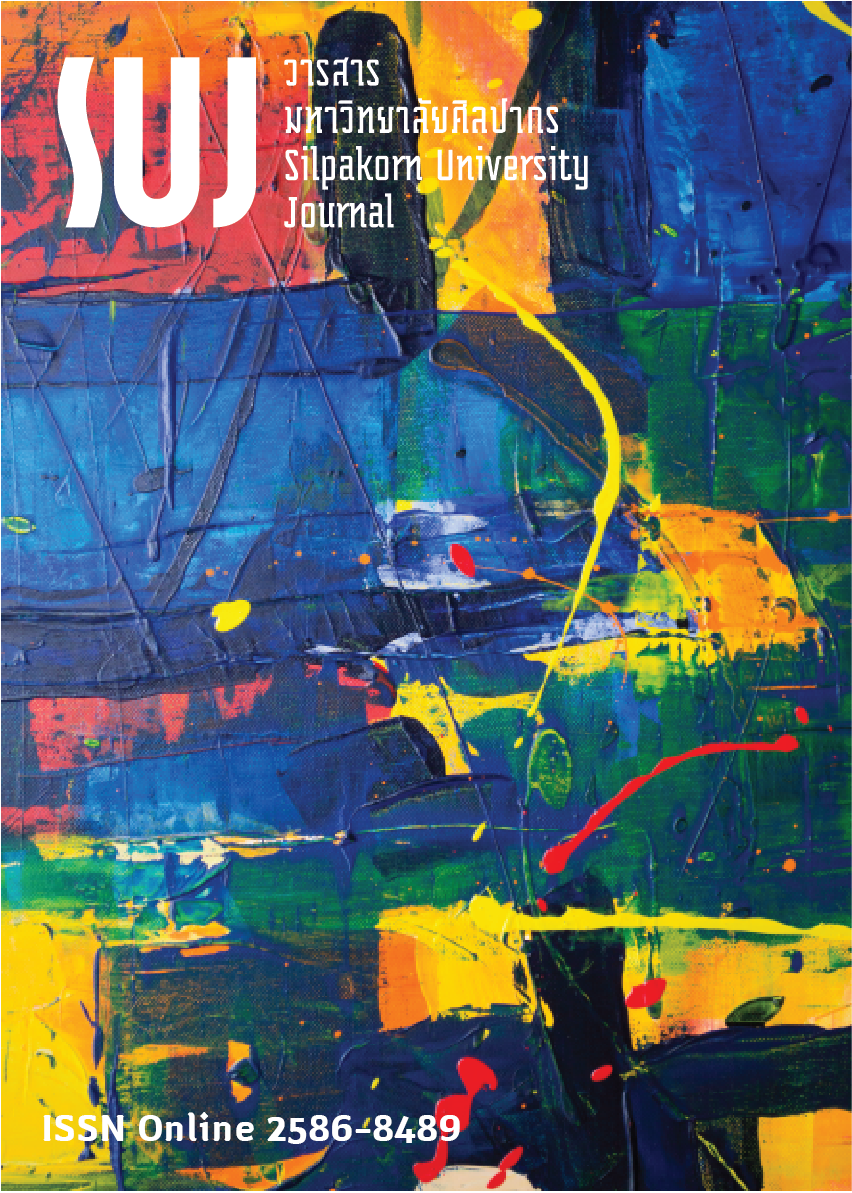การตลาดเชิงสร้างสรรค์และการโฆษณาเชิงเนื้อหาการท่องเที่ยวไทยที่ส่งผลต่อ ความตั้งใจซื้อของนักท่องเที่ยวชาวจีน ญี่ปุ่นและเกาหลีใต้ในรุ่นเจเนอเรชั่นวาย (The Affect of creative marketing and content advertising of purchase intention of Chinese, Japanese, South Korean Tourists’ Generation Y)
Main Article Content
Abstract
บทความวิจัยชิ้นนี้มีวัตถุประสงค์สำคัญคือ มุ่งศึกษาการตลาดเชิงสร้างสรรค์และการโฆษณาเชิงเนื้อหาการท่องเที่ยวไทย ที่ส่งผลต่อความตั้งใจซื้อสินค้าและบริการจากการท่องเที่ยวประเทศไทย ของนักท่องเที่ยวชาวจีน ญี่ปุ่นและเกาหลีใต้ในรุ่นเจเนอเรชั่นวาย เครื่องมือที่ใช้ในการเก็บรวบรวมข้อมูลจากแบบสอบถามภาคภาษาจีน ญี่ปุ่นและเกาหลีใต้ โดยวิเคราะห์ข้อมูลโดยใช้เทคนิคการวิเคราะห์ถดถอยโลจิสติกส์แบบทวิ ผลการวิจัยพบว่า 1) การตลาดเชิงสร้างสรรค์เกี่ยวกับการแบ่งเป็นส่วนตลาด การวิจัยทางการตลาด การโฆษณาช่องทางและการจัดจำหน่าย กรณีการโฆษณาเชิงเนื้อหาเกี่ยวกับลักษณะพิเศษเฉพาะของเครื่องอุปโภคบริโภคประจำท้องถิ่น เหตุการณ์และ สถานที่ตั้งทางประวัติศาสตร์ สินค้าของที่ระลึก และความเสมอภาคทางโอกาสของการช้อปปิ้งต่างส่งผลต่อความตั้งใจซื้อสินค้าและบริการจากการท่องเที่ยวประเทศไทยของนักท่องเที่ยวชาวจีน 2) การตลาดเชิงสร้างสรรค์เกี่ยวกับการพัฒนาสินค้าและบริการ การออกแบบสินค้าและบริการ คุณภาพสินค้าและบริการ กรณีการโฆษณาเชิงเนื้อหาเกี่ยวกับการชมธรรมชาติของแต่ละถิ่นที่อยู่ ลักษณะพิเศษเฉพาะของเครื่องอุปโภคบริโภคประจำท้องถิ่น เหตุการณ์และสถานที่ตั้งทางประวัติศาสตร์ วิธีการคมนาคมขนส่งต่างส่งผลต่อความตั้งใจซื้อสินค้าและบริการจาก การท่องเที่ยวประเทศไทยของนักท่องเที่ยวชาวญี่ปุ่น และ 3) การตลาดเชิงสร้างสรรค์เกี่ยวกับการออกแบบสินค้าและบริการ การบริการลูกค้า ช่องทางและการจัดจำหน่าย และการบริหารงานขาย กรณีการโฆษณาเชิงเนื้อหาเกี่ยวกับคุณลักษณะอาหารของแต่ละถิ่นที่อยู่ โปรแกรมและกิจกรรมการท่องเที่ยว การชมธรรมชาติของแต่ละถิ่นที่อยู่ รูปแบบการดำเนินชีวิตตามกิจกรรมยามค่ำคืน ต่างส่งผลต่อความตั้งใจซื้อสินค้าและบริการจากการท่องเที่ยวประเทศไทยของนักท่องเที่ยวชาวเกาหลีใต้ในรุ่นเจเนอเรชั่นวาย
This research article aimed at studying creative marketing and content advertising of tourism in Thailand influencing Chinese, Japanese and South Korean generation Y tourists’ purchase intentions of goods and service of during their stay in Thailand. The research instrument used to collect research data was Chinese, Japanese and South Korean questionnaires. The data was statistically analyzed, using binary logistic regression. The research findings were as follows. 1) In terms of creative marketing market segmentation, marketing research, advertisement, channels and distribution had an influence on Chinese generation Y tourists’ purchase intention of good and service. In the case of content advertising strategy, the uniqueness of local consumer goods, historical events and locations, souvenirs and equal shopping opportunity all had an impact on Chinese generation Y tourists’ purchase intention of goods and service. 2) In terms of creative marketing, development, design and quality of goods and services had an impact on Japanese tourists’ purchase intention of goods and services. Content advertising related to appreciation of the nature of each place of residence, the uniqueness of local consumer goods, historical events, location and transportation influenced Japanese generation Y tourists’ purchase intention of goods and service. 3) Regarding creative marketing, product design, customer service, channels and distribution and sales administration had an influence on South Korean generation Y tourists’ purchase intention of goods and services. Content advertising associated with the uniqueness of each local delicacy, tourism programs and activities, appreciation of local nature, local life style and nightlife had an influence on South Korean generation Y tourists’ purchase intention of goods and service.
Downloads
Article Details
References
BCG U. S., (2013). Millennial Supplemental Consumer Sentiment Survey. [Online]. Retrieved January 15, 2017 from https://www.hiso.or.th/hiso/picture/reportHealth/ThaiHealth2016/thai2016_3.pdf
Bennett, S. (2013). Stats to convince your boss to invest in content marketing. [Online]. Retrieved November 18, 2016 from https://www.mediabistro.com/alltwitter/social-content-marketing-stats_b46012
Berkman, H.W., Lindquist, J.D., & Sirgy, J.M. (1997). Consumer Behavior. Chicago: NCT Business Book.
Boonprasert, Prayoon. (2012). Guides for promotion and development of longstay tourism (แนวทางการส่งเสริม และพัฒนาการท่องเที่ยวพำนักระยะยาว). Thammasat University, Research and Consultant Institute: 11-14.
Bowdery, R., & Bowdery, R. (2008). Basics advertising 01. Singapore: AVA Publishing.
Cochran, W. G. (1977). Sampling techniques. (3 rd. ed.). New York: John Wiley & Sons.
Cronbach, L. J. (2003). Essential of psychology testing. New York, NY: HarperCollins Publishers.
Department of Tourism. (2016). International Tourists’ Statistics Visit Thailand 2016 (สถิตินักท่องเที่ยวชาวต่างชาติที่เดินทางเข้าประเทศไทย ปี 2559). [Online]. Retrieved May 25, 2016. from https://www.tourism.go.th/home/details/11/221/25516
Department of Tourism. (2016). Originality of Long Stay (ความเป็นมาของ Long Stay). [Online]. Retrieved November 15, 2016 from https://www.2tat.or.th/longstay/thai/index.html
Dumrongvongjarean, Chaiyasit. (1997). Cultural tourism management on participative conservation: A case study pupayon (การจัดการท่องเที่ยวทางวัฒนธรรมเชิงอนุรักษ์โดยมีส่วนร่วมของชุมชน: กรณีศึกษาภูผายนต์ อำเภอภูพาน จังหวัดสกลนคร). Sakon Nakhon: Faculty of Cultural Science Mahasarakham University.
Engel, F. J., Blackwell, D. R., & Miniard, W. P. (1995). Consumer behavior (8 th. ed.). Fort Worth,TX: Dryden Press.
Kuharatanachai, Chuchai. (2003). Introduction to Statistics (สถิติเบื้องต้น). Bangkok: Mahanakorn Technical University, Department of Statistics.
Matichon. (2016). Tourism revenues reach 2.6 trillion within 5 months, international tourists go in Thailand enthusiastically (รายได้ท่องเที่ยวทะลุ 2.6 ล้านล้านบาท 5 เดือน ต่างชาติแห่เข้าไทยคึกคัก). [Online]. Retrieved May 12, 2016 from https://www.matichon.com
Ministry of Tourism and Sports. (2015).Tourism Strategy (2015-2017) (ยุทธศาสตร์การท่องเที่ยว พ.ศ. 2558-2560). [Online]. Retrieved November 16, 2016 from https://www.mots.go.th/ewt_dl_link.php?nid=7114
Mowen, J. C., & Minor, M. (1998). Consumer behavior (5 th ed.). Upper Saddle River,New Jersey: Pearson Hall.
Naipinit, Aree., Kroeksakul, Patarapong., & Promsaka Na Sakolnakorn, Thongpol. (2014). Adjustment under globalization (การปรับตัวภายใต้กระแสโลกาภิวัตน์). Songkhla Rajabhat University Academic Journal, 7(1): 9.
Odden, L. (2012). OPTIMIZE; How to attract and engage more customers by integrating SEO, social media, and content marketing. New Jersey: John Wiley & Sons.
Punyaroj, Suthichai.(2013). Creative marketing (การตลาดเชิงสร้างสรรค์). TPA News Journal, 119(7): 43-44.
Rowinelli, R. J., & Hambleton, R. K. (1977). On the use of content specialists intheassessmentof criterion-referenced test item validity.Dutch Journalfor Educational Research, 2: 49-60.
Schiffman, L. G., & Kanuk, L. L. (2004). Consumer behavior (8 th. ed.). Upper saddleriver. New Jersey: Prentice Hall.
Schultz, D. E., & Block, M.P. (2009). Media generations: Media allocation in a consumer-controlled marketplace. Ohio, OH: Prosper.
Sudden, J. (2003). Material Virtualities. New York: Peter Lang.
Suwanasarn, Tawatchai. (2013). 5 Techniques of content marketing for online (เทคนิค 5 ข้อการทำเนื้อหาทางการตลาดแบบไอน์สไตน์). [Online] Retrieved November 12, 2016. from https://kengtawatchai.blogspot.com/2013/07/5-content-marketing.html
Taylor, J. (2013).Stat to convince your boss to invest in content marketing. [Online].Retrieved November 12, 2016. from https://www.fatjoe.co.uk/author/fatjoetaylor
Thomson, S. K. (1992). Sampling. New York: John Wiley & Sons.
Vanichbuncha, Kanlaya. (2006).Advanced Statistics, with SPSS for Windows (5th. ed.)(การวิเคราะห์สถิติขั้นสูงด้วย SPSS for Windows. พิมพ์ครั้งที่ 5).Bangkok: Chulalongkorn University, Department of Statistics, faculty of Commerceand accounting.
Waltz, C. F., & Bausell, R.B. (1981). Nursing research: Design, statistics, and computeranalysis. Philadelphia: F. A. Davis.
Young, A. (2010). Brand media strategy: An integrated communication planning in thedigital era. New York, NY: Palgrave Macmillan.


